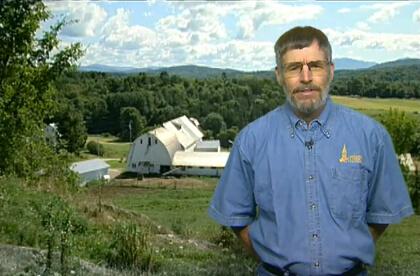“Failure to plan is planning to fail.”
“Any estate that has one penny, or more, can be the cause of a fight.”
“A Vermont farmer would rather endure three weeks of below zero weather, than talk about his feelings.”
These are just a few of Bob Parsons favorite sayings, oft repeated during his talks to farmers on how to transfer businesses, estates and assets. Parsons, an agricultural economist with both the University of Vermont College of Agriculture and Life Sciences (CALS) and UVM Extension, gives about five such talks and workshops every year throughout the U.S. His headquarters are in Morrill Hall in the department of community development and applied economics.
Before an audience, Parsons is animated and engenders bursts of laughter, not just the nervous laughter of recognition and discomfort about planning for the afterlife either.
Making the Most of a Legacy
The audience for “Farm Transfer & Succession Planning” one day in January was the Vermont Christmas Tree Growers Association gathered at the Vermont Farm Show in Essex Junction. They were there to grapple with the same issues that any property owner faces unless he wants to cash out his assets. Parsons led listeners through the personal issues such as procrastination, fairness versus equity and children’s interests and abilities to inherit family businesses. He highlighted tax law changes, estate planning basics and various transfer options. His is also a crash course in business structure.
He speaks from research: Parsons’ material comes from a four-year, nationwide comprehensive study of the ways families transfer their small and medium-sized farms to the next generation – a critical component to the future of U.S. agriculture. The study was funded by a $468,000 USDA National Research Initiative grant and five grants from the Northeast Center for Risk Management Education totaling $265,000. His conclusions mirror Vermont's farm landscape. The average age of a farmer nowadays is 57, a decade older than in the 1970s. Trends show more absentee landowners and more complicated regulations. On the other hand, the number of small farms is on the increase as are efforts to preserve farmland. That’s why Parson’s presentations resonate with his audiences.
He speaks from experience: Parsons tells the tale of his own dad, 88, who created a business plan to hand over his Pennsylvania farm to his adult children yet routinely plans which trees to plant next year. “Now that is long-range planning,” says Parsons, confessing that his dad wasn’t always so well organized. “In the 1980s on the way into heart surgery, he asked his wife not to sell the farm.”
Parsons leaves his audiences with plenty to think about, a 12-page PowerPoint handout and the suggestion that they contact the University of New Hampshire for its websites and course tapes.
“This was helpful for a lot of people here,” said James Horst, surveying the crowd of about 60 attendees that day. His take-away message was “people – the spouse and kids – have to be all thinking and acting in the same direction.” Horst, a Bennington tree farmer with some 300 acres, says he has been through farm transfer as a recipient. And now he’s on the giving end.
“My kids are young, in their twenties – they need time to decide what they want to do,” he says, so his plan includes, “I’ve got to keep alive for a long time.”
